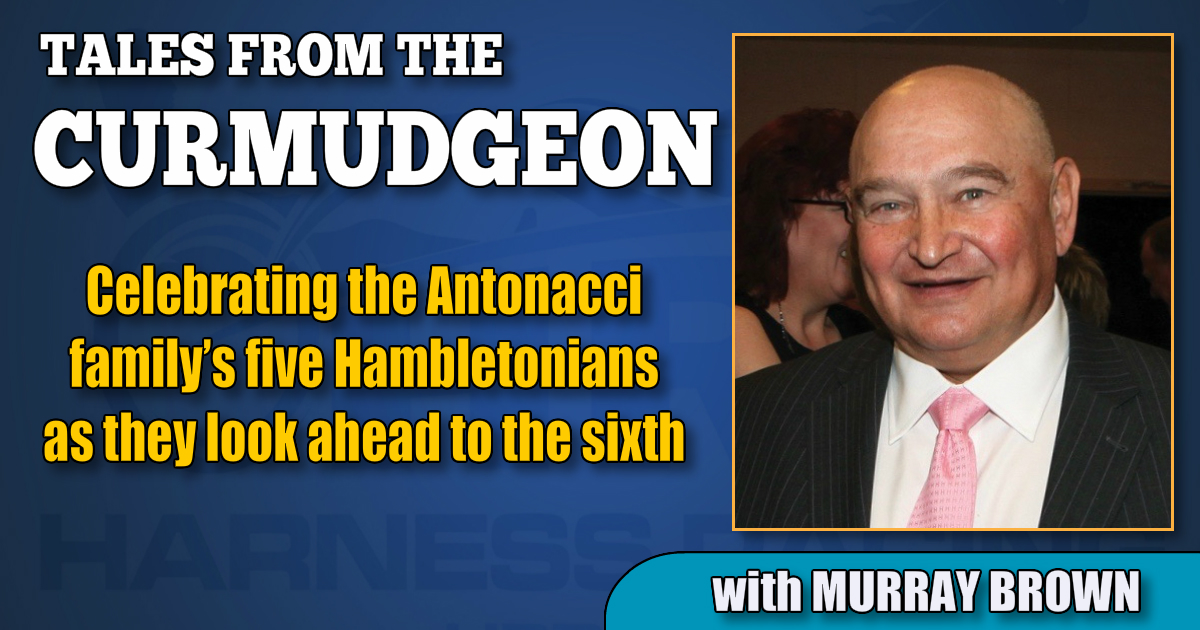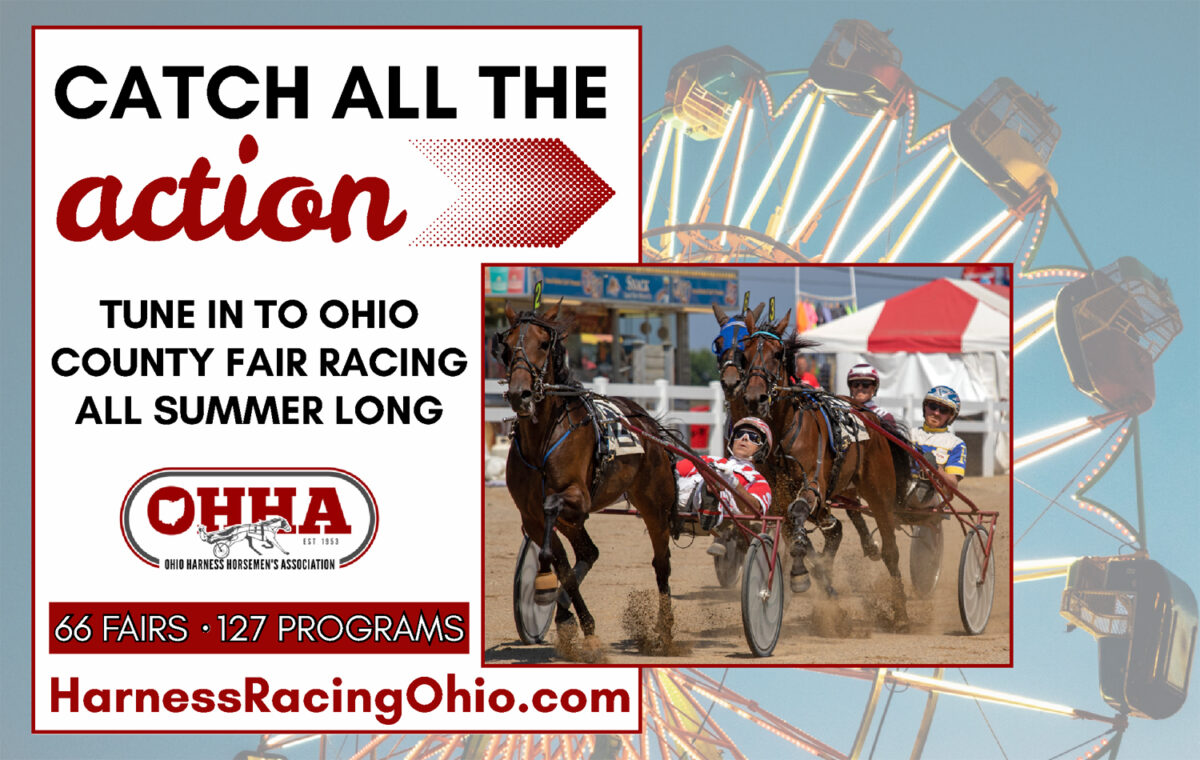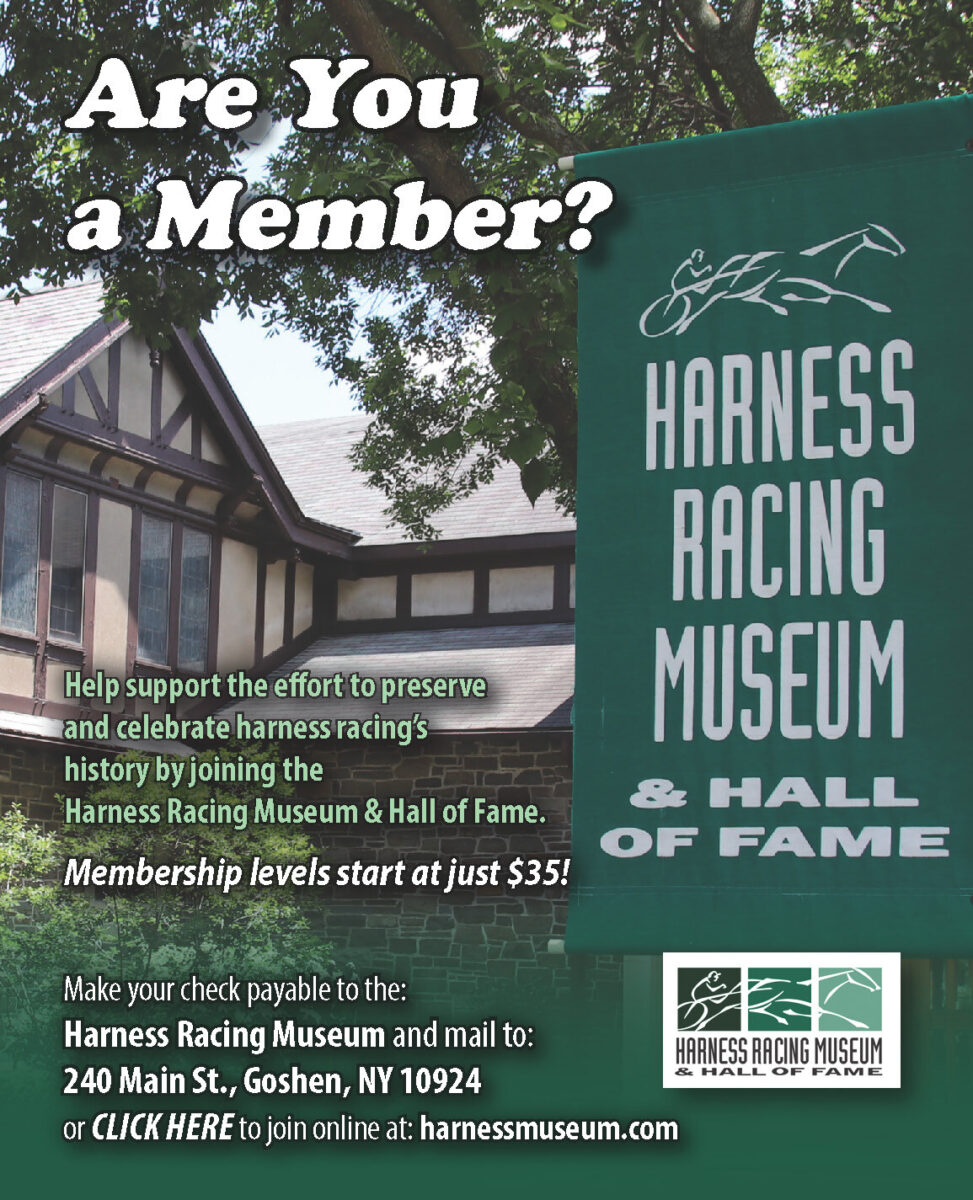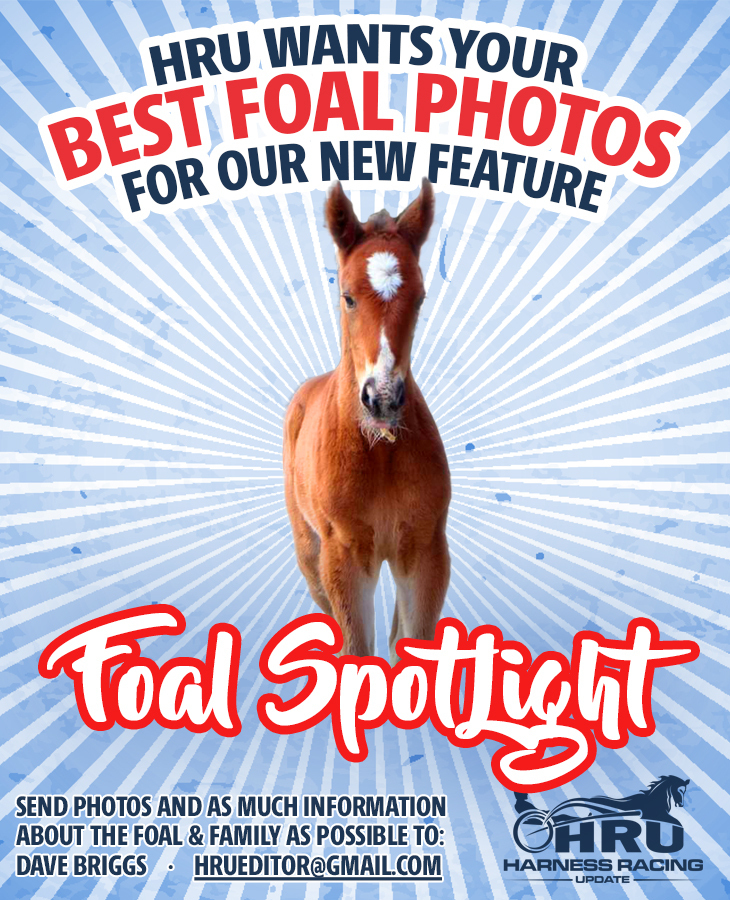Celebrating the Antonacci family’s five Hambletonians as they look ahead to the sixth
by Murray Brown
Last Saturday morning, Frank “The Elder” Antonacci and I were practicing social distancing from our respective cars while watching the babies at Sunshine Meadows.
I was alone in mine, while Frankie was with his youngest son Philip.
I suggested to Frankie that a story on the Antonacci family’s five Hambletonian winners might be of interest.
Philip interjected to say that “five are in the past. How about number six?”
I thought to myself, “How typical of an Antonacci.” That’s something his grandfather Guy “Sonny” might have said. Sonny was always looking ahead. The past was in the past. We need to build on the past and augment the future.
Nevertheless we agreed to talk about the five with some other tidbits thrown in.
We started with the first one, Lindys Pride, who was also the one I was most familiar with.
I knew him as Galahad Hanover, a Stars Pride yearling out of the Spencer Scott mare Galena Hanover.
He was also a member of my first yearling crop at Hanover Shoe Farms in 1967.
He became the seventh Hambletonian winner by his sire in the previous 11 years.
I remember him as a lovely colt who could fly on the lead strip. He could trot a hole in the wind, faster than any lead pony that Hanover had could run.
Going into the sale I was pretty certain that he would be our highest priced yearling trotter and that he would be purchased by Clarence Gaines and K.D. Owen.
I was wrong on both counts.
I had expected him to sell in the $40,000-$60,000 range which was a pretty good price for a yearling trotter back then. Instead, he brought a disappointing $15,000 and was purchased by Howard Beissinger for the Antonacci and Lomangino families.
I remember asking Mr. Owen why he and Mr. Gaines had not bought him, because all previous indications were that they would. He said that right before he sold, Mr. Gaines had asked Dr. John Steele if he had looked at the colt. Dr. Steele said that he had and didn’t like his hocks. He didn’t think they would hold up to racing. So, Mr. Gaines backed off, as did Mr. Owen.
Mr. Owen said if he knew he was only going to bring $15,000, he would have taken a chance and bought the colt by himself.
The chances are that he wouldn’t have got him anyway, because after Howard had bought him, he told me that he been prepared to pay double what he did.
Galahad Hanover’s name was changed to Lindys Pride and he was owned by Sonny Antonacci, his cousins Frank and Tommy Antonacci and another group of cousins, the Lomangino family.
Lindys Pride was a decent, but not great 2-year-old. At 3, he won not only the Triple Crown — the Hambletonian, Yonkers Trot and the Kentucky Futurity — but also the Colonial and the Vernon Gold Cup. These races constituted what was known as the “Big Five”.
He was, at least in my opinion, a truly great colt who history has not quite given the respect that he deserves.
The second, was the one that was destined to have arguably the greatest impact on our sport more than any trotter ever. His name was Speedy Crown. He was a homebred, by Speedy Scot out of the Florican mare Missile Toe, and was bred by Howard Beissinger’s wife Ann.
He was purchased privately by Sonny Antonacci’s cousins Frank and Tommy. They owned him throughout his racing career. In actuality, Sonny’s family never really were involved in the ownership of Speedy Crown, but close enough. Cousins Frank and Tommy worked out a deal with Sonny where lifelong breeding rights in Lindys Pride were exchanged for breeding rights to Speedy Crown.
In retrospect, there is no doubt who got the better of that deal.
Like Lindys Pride, Speedy Crown was just a good 2-year-old, who developed into an exceptional 3-year-old. He wasn’t quite as dominant a sophomore as Lindys Pride, but he was pretty darn good. He won the Hambletonian in straight heats and also set world records in winning the Kentucky Futurity at The Red Mile and the Old Oaken Bucket at Delaware, OH.
As a 4-year-old, he even surpassed his racing exploits at three. He dominated trotting in North America. He won the Roosevelt International, the Realization, the American Trotting Classic and the 1 1/4 mile Challenge Cup. In the latter, he defeated the great trotting mare Une de Mai, then regarded as the greatest trotter in the world and the great Fresh Yankee.
His first crop was relatively average, but from that point onward it was “Katie Bar the Door”. He, together with his contemporary Super Bowl, ruled North American trotting like no tandem of sires ever.
Speedy Crown led the leading money sires listing for 13 consecutive years.
Like some of our great sires, he did not come from one of the most auspicious trotting families, which — it has been my opinion for a long time — is not a necessity for greatness in a sire. In my opinion, they are great simply because they are great. I look upon it as for lack of a better word a “disease” which afflicts very, very few.
The third Antonacci-connected Hambletonian winner was to become the most controversial in the history of the event. He was also to become the first one both bred and owned by the Antonacci family.
His name was Probe. He was a 1986 son of Super Bowl out of the Speedy Crown mare A.C.’s Wonder. His pedigree bore little question. Back then, if you had a good Super Bowl mare you would try to breed her to Speedy Crown. Conversely, if you had a good Speedy Crown mare, you would try to breed her to Super Bowl. They were considered magic crosses for trotters for close to two decades.
In Probe’s case it was the latter choice.
Sonny Antonacci had bought the Hoot Mon mare AC’s Nancy from noted breeder Bill Shehan and bred her to Speedy Crown.
AC’s Nancy, herself was no stranger to Hambletonian winners, since she was a full sister to Hambletonian winner AC’s Viking.
Both AC’s Viking and AC’s Nancy were bred by Connecticut dairy man A.C. Peterson and trained and driven by Hall of Famer Sanders Russell.
After acquiring AC’s Nancy, Sonny Antonacci bred her to Speedy Crown and got a filly that he named AC’s Wonder.
AC’s Wonder was a pretty good race filly, she took a 3-year-old time trial record of 1.58 and earned $84,857.
When it came time to breed her, there was little question as to whom she would be bred. The answer of course was Super Bowl.
The result of the mating was a sharp bay colt that was named Probe.
Probe was generally thought of as a good horse, but far from a great one.
He, like Lindys Pride and Speedy Crown, was a decent 2-year-old. Unlike those two, his 3-year-old season was not spectacular.
He didn’t show the greatness at 3 that the other two did.
The overwhelming favorite 3-year-olds coming into the 1989 season was the colt Valley Victory and the filly Peace Corps. Both were from the very first crop by Baltic Speed. Although Baltic Speed was bred to a large variety of mares after this first crop, including many good ones, he never came close to siring another trotter remotely possessing the talent of those two great ones from his first crop.
Valley Victory got sick before the Hambletonian and was scratched. Peace Corps coming off a 17 consecutive win streak was apparently just tired and threw in a lackluster effort.
Then came the drama.
Park Avenue Joe won one preliminary heat and Probe won the other.
The scene was set for a race off between the two colts.
Park Avenue Joe driven by Ron Waples cut the mile with Probe, driven by Bill Fahy, sitting closely behind him. Just past the three quarters, Fahy pulled on the right line and a tremendous stretch drive ensued. The last quarter was trotted in a ridiculously fast :26.3. They couldn’t be separated at the wire. The result was a dead heat and Park Avenue Joe was initially declared the winner because he stood better in the standings.
The counter argument was made that the standings made no provision for a race off.
A legal battle ensued with the official standing showing that both colts were declared the winners.
The Antonaccis’ fourth Hambletonian winner came the very next year with Harmonious, a Crowning Point colt out of the Super Bowl mare Rhapsody in Blue.
Frank “The Elder” disclosed a tidbit to me, of which I had no prior knowledge. Harmonious was purchased on the strong recommendation of Pat Waldo who the Antonaccis hired to help in scouting out yearling purchases.
Not only had Waldo picked out the Kentuckiana Farms-bred colt in 1988, but the previous year he also picked out the colt that was almost universally considered to be the best in his class — Valley Victory.
Of all the Hambletonian winners they had, Frank “The Elder” said that Harmonious was the one that presented the biggest challenge in getting to the winner’s circle on the first Saturday in August. He had several soundness and gaiting problems.
Although the official record shows that he was trained by Osvaldo Fomia, in actuality, that year, in the thinking-out-of-the-box norm of Sonny Antonacci, he was actually trained by the duo of Osvaldo Formia and Jorn Morton Kvikstedt.
After winning the race, a significant piece in him was purchased by Bill Perretti and he took up stud residence at Wild Bill’s Perretti Farms.
His success on the racetrack was not emulated in the stud. At best, his mark as a stallion would likely be generally considered as disappointing.
The most recent Antonacci Hambletonian winner was Victory Dream. He came from the first crop of super sire Valley Victory and was out of the Speedy Crown mare Crown Dream. He was destined to be another game changer to the breed, but it took an extra generation to get there.
He was bred and raised by Sonny Antonacci’s cousins, the brothers Frank and Tommy Antonacci, sometimes known as the Crown Stable..
He was entrusted to Ron Gurfein to train. Sonny Antonacci bought in after his 2-year-old season.
He was destined to become the first of The Guru’s three Hambletonian winners.
He was a very talented 2-year-old, but sustained an evulsion fracture at two. He was stopped with after The Historic at The Meadowlands.
According to The Guru, the prognosis for his complete recovery was good. The use of magnet therapy was quite helpful in assuring that he returned to the racing wars in sound shape.
Several things I’ve found about Gurfein after observing him for almost 50 years.
He can be opinionated. He can be full of himself. But, he is not a fool. In fact, he is just about as far from being a fool as a human can be.
He is an extremely smart and capable horseman.
One of his greatest attributes is that he knows what he doesn’t know and is always ready to learn or try something different.
Now back to Victory Dream. He came back sound at 3 and there was hardly a point in the season where he wasn’t regarded as the best colt out there.
The offers to buy and/or syndicate him were coming left, right and center.
A tentative deal was struck between George Segal to syndicate the colt to stand at Brittany Farms. However, he was vetted out before the Hambletonian and the veterinarian turned him down. A group of Swedes were also interested in acquiring him.
Alan Leavitt was waiting in the wings next in line and the colt was syndicated by him to stand at Meg Jewett’s Walnut Hall Limited.
There were many, including yours truly, who thought the horse was destined to become one of trotting’s greatest stallions.
He very well might have become just that, EXCEPT that he wasn’t fertile.
Gurfein told me that one of his testicles was the size of a pea and the other not much bigger than a marble.
Thus, the reason for his lack of fertility.
During his time at stud, he sired only 92 foals.
One of them, Self Possessed, captured the Hambletonian and was considered a decent sire.
It was one of his foals, Cantab Hall, who was destined to become a stallion for the ages.
Cantab Hall was a gorgeous yearling who was owned by the Antonaccis, George Segal and a disparate group. He was an amazing 2-year-old, being crowned Trotter of Year in 2003 over all older ones.
He failed to emulate his sire by not winning the Hambletonian, but still finished a credible second.
He was syndicated to stand at stud at Hanover Shoe Farms and has been recognized as one of the world’s leading stallions with every crop that he sired.
SOME TIDBITS
1. Not only did the Antonaccis own five Hambletonian winners, but perhaps just as remarkably, they owned five other colts who finished second in the Classic —M B Felty, Lindy Lane, Cantab Hall, Lucky Chucky and Crazed.Of those, Frank “The Elder” thought Lindy Lane was his greatest disappointment, even though he finished a most credible second to the incredible filly Continentalvictory. No other trotter was going to beat her that day..
2. Osvaldo Formia was directly involved with four of the five. He was the groom of Lindys Pride and Speedy Crown and the trainer of Probe and Harmonious.
Have a question for The Curmudgeon?
Reach him by email at: hofmurray@aol.com.

















